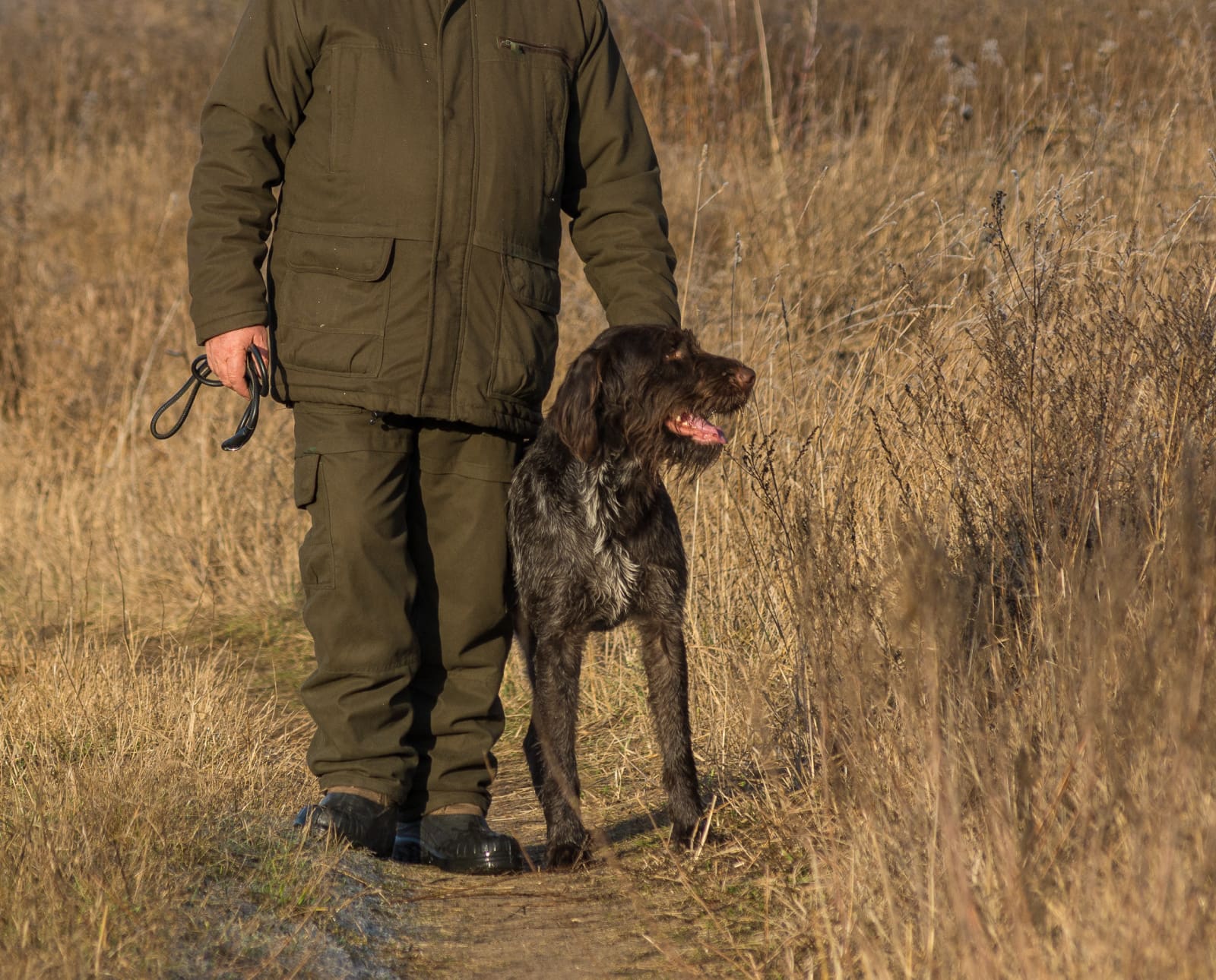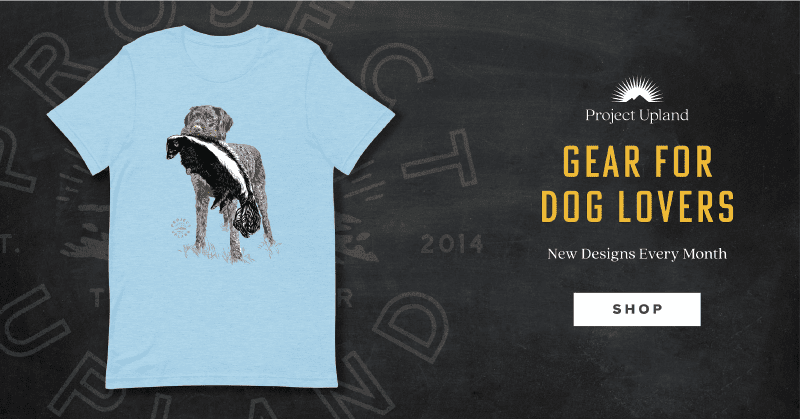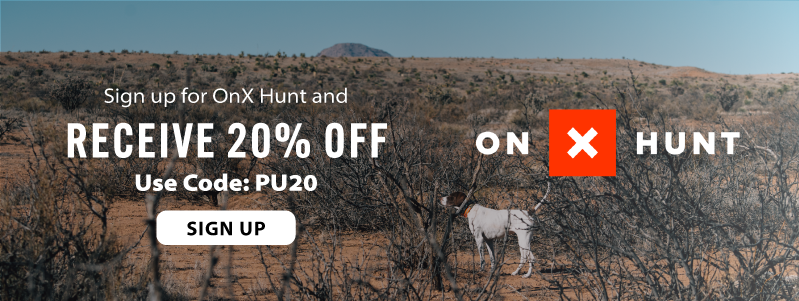Home » Hunting Dogs » How to Prepare a Dog for the VJP Test
How to Prepare a Dog for the VJP Test

Jennifer Wapenski is the Director of Operations and Managing Partner…
Getting your dog ready to run in the puppy natural ability test for the German versatile dog system
As a new owner of a versatile hunting dog, you’ve probably been asked about running in a natural ability or puppy hunt test. Some breeders may request or require that puppy buyers run in a test, while other owners may stumble into the puppy test through local club chapters such as NAVHDA or AKC. For owners of the German-registered breeds—such as the Deutsch Drahthaar, Deutsch Kurzhaar, Deutsch Langhaar, Kleine Munsterlander, and others—the puppy test takes the form of the Verbands-Jugend-Prüfung, or the VJP.
Listen to more articles on Apple | Google | Spotify | Audible
What is the VJP?
Like the NAVHDA Natural Ability test or the AKC Junior Hunter test, the VJP is a one-day test intended to assess the natural hunting abilities of your versatile hunting pup. It is a pass/fail test and not a competition, so all entered dogs have an equal chance to receive a great score and a “pass.”
Dogs must be registered with the Fédération Cynologique Internationale (FCI) to run in a VJP. Generally speaking, that means a dog that was bred within a breed club that operates under a foreign club’s jurisdiction such as the Verein Deutsch Drahthaar — Gruppe Nordamerika (VDD-GNA). It’s a bit complicated, but suffice it to say that if you’re eligible to run in a VJP, it’s likely that your breeder already mentioned it and encouraged you to do so.
Puppies must run the VJP test in the spring after they were born, unless they were born on or after October 1st. Fall and winter puppies can wait until the following year to test, ensuring that all puppies have an opportunity to experience a hunting season before being tested for their natural hunting abilities.
Testing puppies is valuable to the breeds overall because it validates the breeding program and ensures that critical hunting skills are being maintained. It’s also a fun activity for handlers to participate in with their dogs.
Listen to: East of the Rhine – Pointing Dog Breed Origins

What subjects does the VJP evaluate?
The VJP consists of only three test events: a field search, an opportunity to point a bird, and a live rabbit or hare track.
In addition to the dog’s performance in these three subjects, judges will also be evaluating the dog’s use of nose, cooperation, gun sensitivity, obedience, loudness on furred game, and overall temperament, as well as physical characteristics.
It’s worth noting that the evaluation of each dog is conducted for the entire day, including when the dog is back at your truck in between test events, so any issues that may arise (such as temperament or lack of cooperation) will be noted and judged accordingly.
Scores are given for the dog’s ability to track, use of nose, searching ability, pointing ability, and cooperation. These five scores—on a scale of 1 to 10 with the possibility of “extra credit” up to 11 or 12 for exceptional work under extenuating circumstances—are tallied up for a final score. Obedience, gun sensitivity, temperament, loudness, and physical characteristics are noted on the score sheet but not given a numerical score.
How to register for the VJP
It’s been said that the hardest part of a VJP is getting into one, and I cannot dispute this fact. Testing opportunities can be few and far between depending on your geographic region. Since the test must be conducted with wild rabbits or hares, the tests must be located on grounds with a sufficient population to give every testing puppy a few attempts on fresh tracks.
The test may be hosted by a breed club or by a multibreed testing organization such as JGV-USA, NA-JGV, or JGV-Rocky Mountain. The entry form is the same, though the fees may vary slightly between organizations. Test announcements will list the name and contact information for the test director who must receive your registration form, pedigree copy, and entry fee to reserve your spot. Act quickly because VJPs tend to fill up very soon after the test is announced.
If you have any questions about finding a VJP and registering your dog, don’t hesitate to ask your breeder for help.
How to prepare your dog for the VJP
The easiest way to prepare your pup for a VJP test is to hunt it in the season leading up to the test. This real-world exposure is invaluable for teaching your pup that there are birds out there for it to find. Once it has this confidence, you’ll notice a huge improvement in its enthusiasm and searching, tracking, and pointing abilities.
Besides hunting, you can work on some basic field training to better expose your puppy to the scenarios she’ll encounter on test day. Above all, you want to ensure that the puppy doesn’t have any brand-new experiences on the test day itself. She should have already smelled planted birds, been followed around a field by a gallery of strangers, and encountered a live rabbit or jackrabbit. You want the pup to approach the event with plenty of confidence from past experiences.
Field search preparation
Depending on the age and personality of your pup, it may or may not have a lot of confidence in working a field away from your side. Give it plenty of opportunities to run off-leash in fields while you walk with a shotgun. Practice light handling by walking a zig-zag pattern across the field, blowing a whistle each time you make an exaggerated turn. Soon, the pup will learn to look to you at the sound of a whistle and adjust its path to stay in front of you.
Once your pup is searching with confidence, ask some friends to walk along behind you to mimic a gallery of three or four judges accompanying you. For some dogs, this addition can be fairly distracting, so it’s best to practice this ahead of the test.
Hopefully, this was already addressed before or during your hunting season, but if not, be sure to properly introduce your dog to gunfire well ahead of the test. They need to be able to continue hunting confidently after multiple shotgun blanks are fired.
Pointing preparation
Be sure to plant some birds for your pup before test day, especially if it has only encountered wild birds while hunting. It will need to be comfortable pointing pen-raised birds that carry human scent.
Don’t overdo the pointing practice, however. While it’s really fun as handlers to watch our young dogs freeze into a staunch point, it can be frustrating for the dog to point over and over again in a training scenario. You don’t want them to get bored and lose enthusiasm for planted birds.
Tracking preparation
The rabbit track is often the hardest part of the test because our North American dogs tend to spend more time hunting birds than tracking furred game. Again, this is simply a question of exposure and experience.
Depending on your state regulations (be sure to check them carefully), you may be able to release a trapped rabbit or run your dog on a wild rabbit. You can also check with local beagle clubs for resources on rabbit tracks. At first, it doesn’t matter if the dog sees the rabbit—a good chase will be plenty rewarding for the excited pup. But at some point, the dog will need to learn how to be shown the start of a track and given a command to start following the trail without seeing the rabbit.
If you don’t have access to many live rabbits, or if you just want to diversify your training a bit, drags are a helpful way to teach your dog to follow ground scent.
From a very young age, teach your puppy to trust its nose and follow a scent trail to a fabulous reward. We start our puppies with cheese tracks across the kitchen floor, dragging a small piece of cheese in a path of increasing difficulty and leaving the cheese at the end for them to find. You’ll be amazed at how quickly they pick up this skill—and a love for cheese—after just a few tries.
This activity will eventually graduate to dragging game animals (outdoors this time!) to create a scent trail for the pup to follow. You can leave the animal at the end of the trail, or else you can save the temptation to play with the game and replace it instead with a high-value treat such as canned food. You may want to use flags or tape (or a helper with a good visual memory) to mark the trail so that you can clearly identify it later. Once the drag is laid, bring your dog to the start, making sure they didn’t see you create the trail, and indicate the start of the scent trail. Try the first few with the dog on a lead, but, eventually, you’ll want to be able to release the dog and give them a command to “track.”
Dogs have a very high degree of situational awareness, so your consistency in how you release for a track will make a big difference in your dog’s understanding of the task at hand. For example, if you always start a field search with your dog sitting calmly and say something like, “Hunt ’em up,” then make sure you have a different start to a scent track. You might choose to command your dog to lay down, point to the ground, or take a moment to run a slip lead through their collar. Whatever you do, make sure it’s different from the start of a field search and consistent every time.
Physical exam preparation
At some point during the test, the judges will perform a cursory evaluation of your dog’s physical characteristics. Prepare for this by getting your dog accustomed to being gently restrained while a stranger looks into its mouth to check bite and teeth.
Practice this with as diverse of a group of friends as possible: men, women, men with facial hair, women with glasses, smokers… try to help your dog generalize so that she isn’t scared, shy, or defensive when this happens at the test.
Obedience preparation
The VJP is a test of natural abilities and not trained subjects, but the judges do want to see that your dog has some basic obedience skills. This may also factor into their cooperation score, depending on how egregious (or impressive) their behavior may be.
A solid recall will save you and your dog a lot of headache on test day. It’s OK if your dog is chasing the flushed bird and doesn’t come back to your whistle right away—in fact, obedience is specifically evaluated while not in the presence of game—but it’s a good look if you can get your dog back quickly and not spend half the day trying to capture a runaway dog. Basic manners and a good recall will be everything you need to impress the judges with your dog’s obedience level.
Heeling and/or loose-leash walking is not required, but it will go a long way toward your own comfort. There is a lot of walking in a VJP, especially when the group is walking the fields in search of rabbits to flush. If your dog spends the entire day pulling on the lead, both you and your dog will be exhausted when it’s time to focus on the rabbit track. A calm dog is a focused dog, so giving them enough skills and experience to walk calmly can make a big difference in your success and your enjoyment of the day.
Remember, too, that everything is heightened on test day—your stress level, the dog’s stress level, and the overall energy. Try to find opportunities to practice basic obedience and manners in higher-stimulation environments such as training days.
What to expect on test day
If you have an opportunity to attend a VJP as a spectator (without your dog) or as a volunteer, take advantage of it! Having a mental picture of how the day is run will go a long way towards easing your anxiety and transmitting calm confidence to your dog.
Test days will start with a handler’s meeting at an appointed time and location. These are often rural locations so it’s a good idea to scout out the meeting place the night before. Again, anything you can do to ease your nerves will go a long way toward your dog’s success in the test.
There will be up to five puppies in a group, though multiple groups may run on the same day and rotate between locations. The test events can be run in any order. The day’s running order will be announced at the handler’s meeting, so remember your number and which dog you follow. Everyone will appreciate handlers who pay attention and know when it’s their turn.
The field search will begin with some basic instructions about where the judges want you to walk. They’ll advise you to “just hunt your dog” as if you were out and about on any average hunting day. Ideally, your dog will effectively cover the field, checking likely cover and ranging out at an appropriate distance. At some point, you will be instructed to fire a blank round into the air. The dog’s reaction to the shot will be evaluated, then repeated after some time has passed. You may also be asked to lightly handle your dog with a few changes in direction. The judges are looking for a cooperative relationship and a dog that adjusts to hunt with you. There are no planted birds for this portion of the test, but should a wild bird be encountered, the dog will be evaluated on how it handles the find.
The pointing section of the test begins by planting a couple of birds in a field. Again, the judges will advise you on where to walk and in which direction the wind is blowing. Once your dog encounters the bird, she will be expected to establish a point. Listen to the judges, who will either instruct you to stay put for a few seconds or to walk toward your dog, depending on your distance and what they are evaluating at that moment. Once they are satisfied, you’ll be instructed to leash your dog, meaning the evaluation is over and you are free to leave the field. You may be asked to remain and work a second bird if the judges have additional questions or if the dog needs a second chance to succeed. If the bird should flush and your dog gives chase, don’t worry about it, just calmly recall your dog. This is not a test for steadiness, but rather a natural point that is appropriate for the pup’s age.
Depending on the local rabbit population, the tracking portion of the test may take the most time to complete. Ideally, each dog will be given two to three tracks to work, which means that the group will need to flush 10 to 15 rabbits. The judges will recruit volunteers (not handlers) to walk in a “beating line” across the field. Handlers will follow with their dogs on leash. Follow the instructions from the judges about remaining close enough to be called up for a track, but far enough away that the dogs can’t see the rabbits. When a judge or volunteer sees a rabbit, they will immediately call out for the judges to observe the track. Once the rabbit is out of sight, a dog will be called up and a judge will indicate the start of the track to the handler. It’s important to get to the starting point quickly, but then slow down and take a breath. Remember how you ran drags and tracks with your dog in training and try your best to replicate it at this moment—it should all feel very familiar to your dog.
Once the dog is released, the judges will be evaluating how well it works the track, whether it stays focused on the task, and how it handles itself when it loses the track. Different dogs will work tracks differently—some with their nose to the ground, others working the air downwind of the track—but they should show focus and persistence either way. Once the judges are satisfied, you’ll be instructed to recall your dog and return to the other handlers behind the line. This process will be repeated until each dog has had sufficient opportunities to demonstrate its natural tracking abilities.
At some point during the day, the dogs will be checked for basic physical attributes and have their identities verified via tattoo or microchip. Follow the instructions from the judges regarding how they want your dog to be positioned and held. This typically goes pretty quickly; it’s not a conformation evaluation, but rather a quick check for any faults to be noted on the dog’s record.
Once the test has concluded, the judges will meet to discuss their notes and agree upon final scores for each dog. These scores will be announced to the handlers along with any comments on what the judges noted about the dogs. Breathe a big sigh of relief, hug your dog, and be proud of what you’ve accomplished together regardless of the results.
…then sign up for the HZP, because you’ve only just begun this testing adventure.
Jennifer Wapenski is the Director of Operations and Managing Partner at Project Upland Media Group. She has a lifelong passion for the outdoors, dogs, and wildlife; as an adult, she discovered that upland bird and waterfowl hunting were natural extensions of these interests. What started as initial curiosity soon escalated into a life-changing pursuit of conservation, advocacy, and education. Jennifer serves in a variety of roles such as the Breed Warden for the Deutsch Langhaar—Gruppe Nordamerika breed club and on an advisory committee for the Washington Department of Fish and Wildlife.






True the most difficult part is finding a test. We are in SC heading to IL wish us luck
Enjoyed your article Jennifer! Your breeder is your friend getting prepared for these tests, ask lots of questions. I also enjoy your IG page, thanks for sharing.
what make and model is the hunting vest in the image?
Hi Carol, that’s a Final Rise vest
The VDD-GNA website has a link on their site for very good videos that deal exclusively with the VJP, HZP, and VGP tests. They explain the tests and give more in depth help for preparing for them. Look on the Testing page.
One things needs to be added here is that if you have a DK (Deutsch Kurzhaar) you can run your pup in Derby which is the NA test for DKV club. It is very similar to VJP apart from hare / rabbit track is not required. If during the test a bunny gets flashed out a judge might ask you to put the pup on the tack. If the pup does well he might get 4h, the highest score, in use of nose the highest score.
DK can participate in Darby and VJP, but no other breed can run in Derby as it is specific to the DK.
My suggestion is that if own a DK train for both sign up for both.